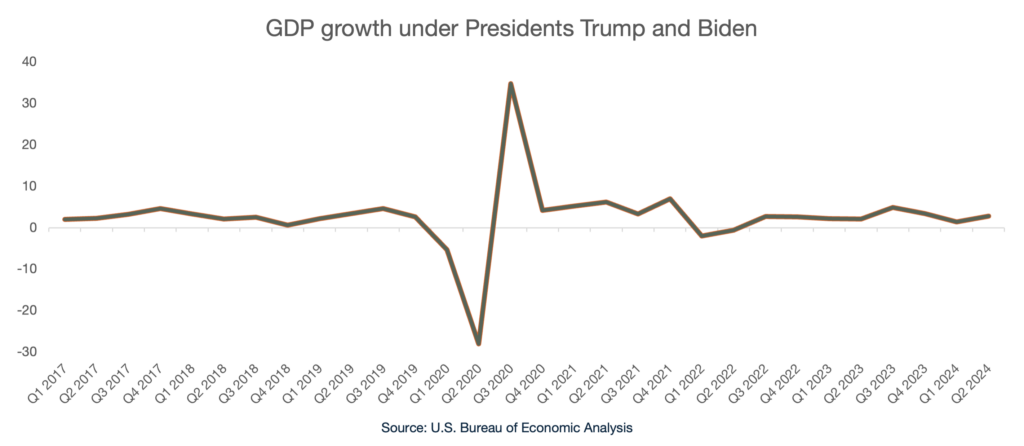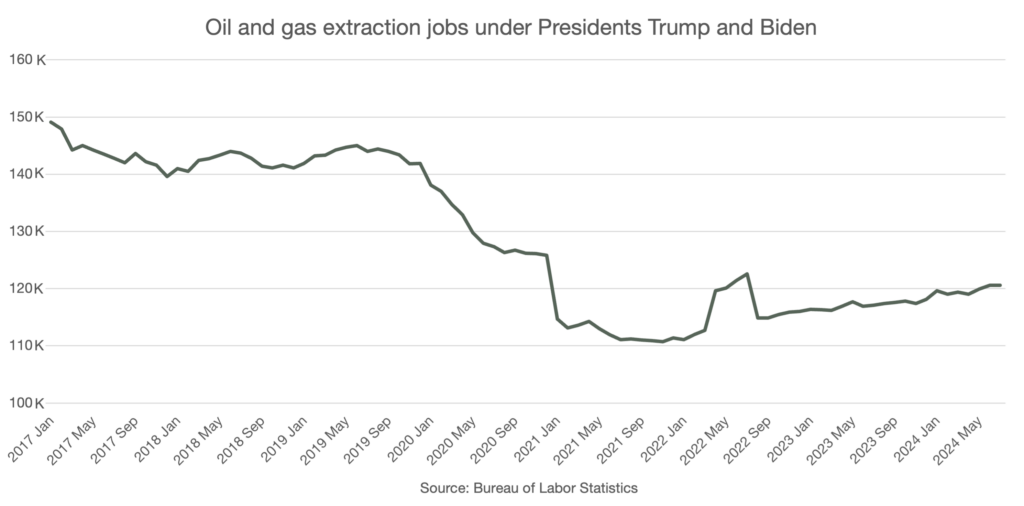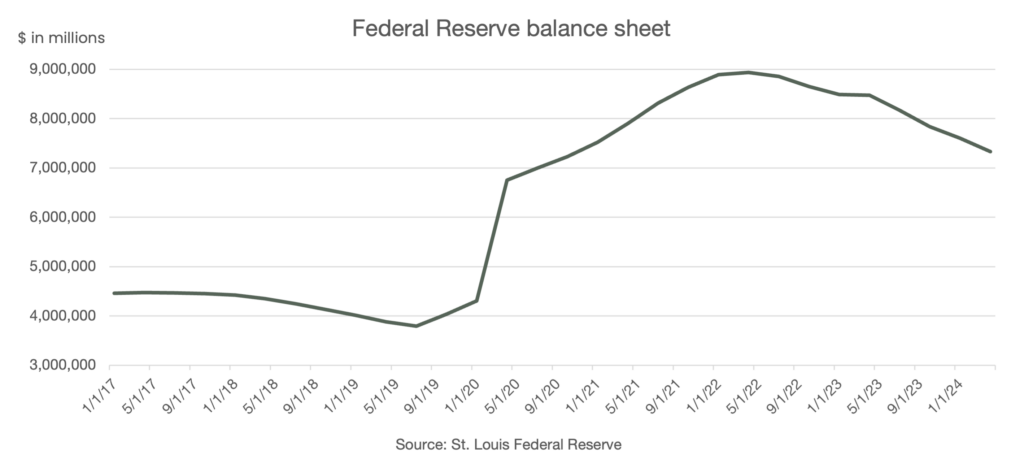Politicians love to throw around economic statistics and jargon to win votes. The U.S. economy fluctuates far less than campaign rhetoric implies, however. We put together a primer to help you cut through the spin in the leadup to November.
One thing to keep in mind: Much of the trend data we’ll share here reflects the significant economic impact of COVID. We’ll do our best to call that out as we go.
The overall economy
If you want to know how healthy the U.S. economy is, gross domestic product (GDP) is the go-to number. GDP is the monetary value of all the goods and services produced by a country. Think of it as a snapshot of the economy. When you compare snapshots, you start to see whether the economy is growing or shrinking over time.

The average annual growth rate for the economy is roughly 3.2%. If you remove 2020 from the equation to account for COVID-19, the economy grew roughly 2.7% per year under both Trump and Biden.
The big takeaway? The economy was generally strong under both presidents. Of course, GDP often doesn’t reflect how Americans feel about the economy. That requires us to dig a bit deeper.
Employment and jobs
At a personal level, having a job (or being able to find work) is a major part of financial security. If we can find work and are earning good money, we tend to view the economy more favorably. Despite that, the job market’s relationship with the overall economy (and the stock market) isn’t always clear cut.
Consider improvements in technology that can increase productivity (and boost GDP) but may eliminate some jobs in the process. Similarly, companies who pay workers more may boost the economy (if those workers in turn spend more on goods and services), but that could take dollars away from an investment in research that might boost the future economy.
These intricacies are where politicians spend most of their time and energy. However, the debate over the details can detract from the big picture. Consider unemployment under the past two presidents.

For context: The long-term historical average unemployment rate is 5.69%.
If those numbers feel off to you, it may come down to the industry you work in. As you might expect, the type of worker companies want evolves over time. Consider the oil and gas industry. The number of people working in oil and gas declined dramatically starting in 2015 and continuing through the Trump presidency before recovering slightly during the Biden administration.

Of course, there’s more to the energy industry than just extraction; these numbers are simply a snapshot. If you’re curious which sector of the economy provides the most jobs, it’s education and health services which have more than 36 million workers.
Sources: Department of Labor
Big government and small business
What many people don’t realize, including politicians, is that the headline jobs report numbers only represent about 80% of workers in the U.S. It excludes farm workers, active military, non-profit workers and anyone self-employed.
Plus, for all of the debate around big or small government, the government is a major employer in this country—some 23 million Americans hold government jobs. The vast majority, close to 20 million, work for state and local governments as teachers, police officers, and so on. (In other words, not your stereotypical bureaucrats.)
If you hear a politician say small business is the backbone of the American economy, there’s data to support it. Within the private sector, small businesses provide 54% of the jobs; large corporations come in at 44%.
Sources: Statista, St. Louis Federal Reserve
Let’s talk taxes
Many politicians want corporations to “pay their fair share” while disagreeing on what that means in practice. To better understand what they’re debating, let’s recap where tax rates are currently.
In 2018, President Trump signed the Tax Cuts and Job Act into law, cutting the corporate tax rate from 35% to the current (and permanent) 21%.
That doesn’t mean companies pay 21% of their profit to the government each year, however, companies can get strategic to reduce their tax bills meaning they may not pay anywhere near that nominal rate.
- Netflix made $6.2 billion in profit in 2023 and paid less than $1 billion in taxes for an effective tax rate of 13%, according to its regulatory filings.
- Microsoft made nearly $63 billion in the US for fiscal 2024 and paid an effective tax rate of 19% according to its regulatory filings.
- Tesla, which paid an effective income tax rate of 8% in 2022 paid no income tax in 2023 and in fact received a $5 billion tax credit (a -50% effective tax rate) for the year, according to its regulatory filings.
On the personal tax side, the 2018 legislation increased the standard deduction significantly, meaning fewer Americans itemized their taxes. That provision is set to expire at the end of 2025 when the next president is in office.
Tax vs. tariff
These days, the economy is largely global, meaning American prosperity may be connected to our major trading partners. While much of the political conversation tends to focus on U.S. trade with China, we do significantly more trade close to home. Let’s look at the numbers:

Overall, the U.S. trade deficit (as a percentage of GDP) shrank from 2022 to 2023, though we’re still a net importer. In 2023, the U.S. exported nearly $3.05 trillion in goods and services and imported about $3.83 trillion.
The government can influence trade via tariffs. As a refresher: Tariffs are a tax charged on imported goods. If the U.S. imposes tariffs on item X from country A, American buyers of item X pay the tariff, not the exporters in country A.
In other words, the government may be hoping that higher taxes, and therefore higher prices, discourage Americans from buying item X from country A. Sometimes the government will do this in response to tariffs imposed on U.S. exports, making it harder for American companies to sell their products overseas.
Printing money
Another favorite talking point? Fiscal responsibility. There are three primary talking points when it comes to scrutinizing how the government manages money.
First, the deficit—this refers to the annual budget passed by Congress. If the government spends more than it makes, it runs on a deficit. Most of the time, the government runs on a deficit; Congress last passed a balanced budget in 2001.
Continual deficits mean the total national debt—how much the government owes, primarily via Treasury bonds—increases significantly every year.
Finally, politicians love to discuss printing money. While the president can simply request the Treasury Department print more money, there’s another contributor that’s not tied to which party controls the White House (or Congress): The Federal Reserve.
When the Federal Reserve hopes to stimulate the economy, it cuts interest rates. If rates are already at zero, the central bank often expands its balance sheet to help. How the Fed does this can be quite complicated, but it results in Treasury printing money.

The balance sheet increased and shrank in response to global events versus which party was in control. For instance, the balance sheet spiked during COVID and began to contract significantly as the economy recovered. While this approach can lead to inflation, it doesn’t always—the Fed expanded its balance sheet significantly following the Financial Crisis and inflation remained steady. Keep in mind: A certain amount of inflation (2-3%) is healthy in a growing economy.
What do these stats mean?
As politicians start to paint a picture of the economy that fits their narrative and policy objectives, it can be helpful to keep bigger-picture reference points in mind. Historically, the U.S. economy is robust and skews towards growth, driven in large part by American innovation. Over the past eight years, the country has seen two presidents on opposite ends of the spectrum ideologically as well as a major, unprecedented global event… and still, the trends point towards continued growth. Much like investing in the stock market, taking a long view can help you stay focused and ignore the noise.
If you have questions about how specific policy proposals might affect your financial plan, feel free to reach out.
